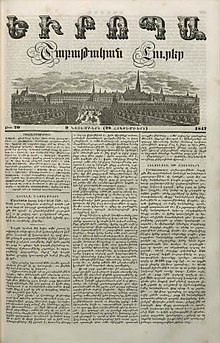Armenians in Austria
This article needs additional citations for verification. (August 2017) |
 | |
| Total population | |
|---|---|
| 6,000 | |
| Regions with significant populations | |
| Vienna | |
| Languages | |
| Armenian, German | |
| Religion | |
| Armenian Apostolic Church | |
| Related ethnic groups | |
| Armenians in Germany, Armenians in Hungary, Armenians in Switzerland |
| Part of a series on |
| Armenians |
|---|
 |
| Armenian culture |
|
By country or region |
Armenian diaspora Russia |
| Subgroups |
| Religion |
| Languages and dialects |
|
| Persecution |
|
Armenians in Austria (
History
Prior to the late 18th century
The history of Armenians in Austria dates back to the time of Vienna's liberation from the Turkish siege at the end of the 17th century, when several Armenian merchants found a new market in the Habsburg empire.
In fact, the city's characteristic coffee culture was established and run for a long time in its early decades by Armenian merchants. The very first documented coffee house in Vienna was opened on 17 January 1685, by Johannes Deodat (or Diodato, known in Armenian as Owanes Astouatzatur – Յովհաննէս Աստուածատուր – some sources claiming him to be Greek).[2][3][4]
After the 1770s Austrian annexations of Galicia and Bukovina

In 1772–1774, the Austrian Empire annexed
At the beginning of the 19th century, the Austrian Armenians enjoyed officially recognized status as an autonomous religious community. The Armenian community in Vienna grew constantly, so that already in 1896 the first efforts were made to found an Armenian-Apostolic community. In 1912, a small chapel was established in Vienna.
WWI and its aftermath
World War I and its aftermath transformed the Austrian Armenian community: The area of the Bukovina Armenians was lost during the war, but a wave of immigrants came to Austria as a result of the Armenian genocide perpetrated by the Ottoman Turks in 1915. After 1918, Galicia became part of a re-established Poland again, while the Bukovina region and much of its Armenian population became part of Romania (and in 1947 was turned over to the USSR and today Ukraine, which prompted most of its Armenian population to leave to Poland and Czechoslovakia after 1947).
After the appointment of the first Armenian pastor in Vienna in the 1920s, the number of Armenians in Austria continued to grow, also boosted by refugees from Lebanon, Syria, Iraq, Iran, as well as migrant Armenian workers from Turkey and more recently from Armenia.
After 1945
In 1968, the Surp Hripsime Armenian Apostolic Church of Vienna was consecrated, giving a new impetus to the ever growing Armenian community in Austria. There is also a Saturday Armenian School named Hovhannes Shiraz.
Both countries established diplomatic relations in 1996. Armenia has an embassy in Vienna and Austria is represented in Armenia through its embassy in Moscow (Russia).
Mechitarist Order in Vienna (1810–present)
Although the monastic headquarters of the
Even much before, actually in 1775, Maria Theresa had already given the official permission to the
By 1810, they established a new monastic center in
Due to financial issues, the construction of the designed church failed to materialize for a few decades. When the church was finally built, a new architect called Fritz Sitte had already altered the designs considerably. He, and later his son Camillo Sitte finished building the church in 1874.
Vienna Congregation is not just a religious center, but a veritable cultural center for Armenians as well. The monks especially cultivated the
The Vienna branch has been publishing Handes Amsorya, a scholarly publication on Armenian linguistics and philology, since 1887.
The library of the Mechitarist Congregation, founded in 1773, owns a special collection of Armenian and Oriental manuscripts (approx. 153,000 vols., 2,000 manuscripts, numismatic collection). The Library has recently announced the formation of the digital list of the Library's books and manuscripts available online.
An association was formed for the propagation of good books worldwide to all Armenian communities, and a high-quality printing press that published average of six new works each year.
A herb liquor called "Mechitharine" and produced by the monks is said to contain 43 herbs and 12 fruits – the precise ingredients and recipe remains is a secret and known by only two monks at a time. The Mechitharine is still produced today and sold commercially by the monks.
See also
- Category:Austrian people of Armenian descent
- Armenia–Austria relations
- Armenian diaspora
- Johannes Diodato [de] (Johannes Theodat [], Owanes Astouatzatur [de]) (1640, Istanbul–1725, Vienna)
- Mechitarists
- Armenians in France
- Armenians in Germany
- Armenians in the Czech Republic
- Armenians in Poland
- Armenians in Slovakia
- Armenians in Hungary
- Armenians in Romania
- Armenians in Moldova
- Armenians in Ukraine
- Armenians in Serbia
- Armenians in Croatia (Armenia–Croatia relations)
- Armenia–Finland relations)
- Armenians in Albania
- Armenians in North Macedonia
- Armenians in Bulgaria
- Armenians in Greece
- Armenians in Turkey
- Armenians in Italy
- Armenians in Spain
- Armenians in the Netherlands
References
- ^ ArmenianDiaspora website Archived 2013-05-11 at the Wayback Machine
- ^ "COFFEE". Werbeka.com. Retrieved 28 August 2017.
- ^ "Café Wien :: History of the Viennese Coffeehouse". Cafe-wien.at. Archived from the original on 29 August 2017. Retrieved 28 August 2017.
- ^ "Coffee - Viennese institution - coffeehouse". Archived from the original on 2012-05-09. Retrieved 2012-09-22.
External links
- The Mechitarian Library in Vienna
- "Une curiosité ethnographique: Les Arméniens d'Autriche". Servet-i-Funoun Partie Français (in French). LIV (1402): 1, 3–4. 1918-07-18.

